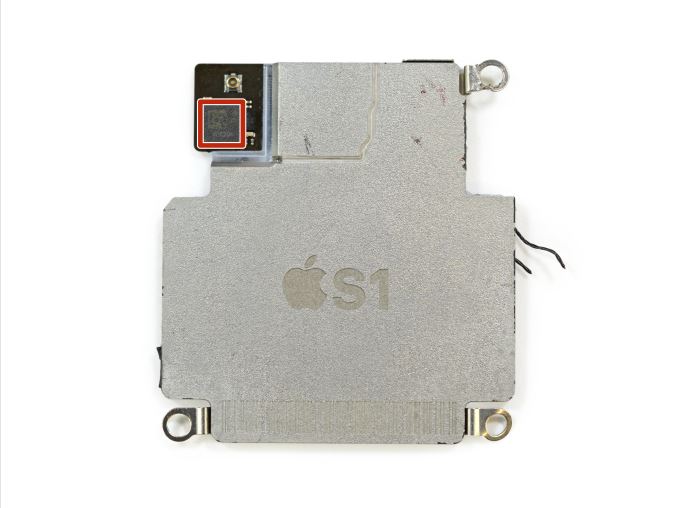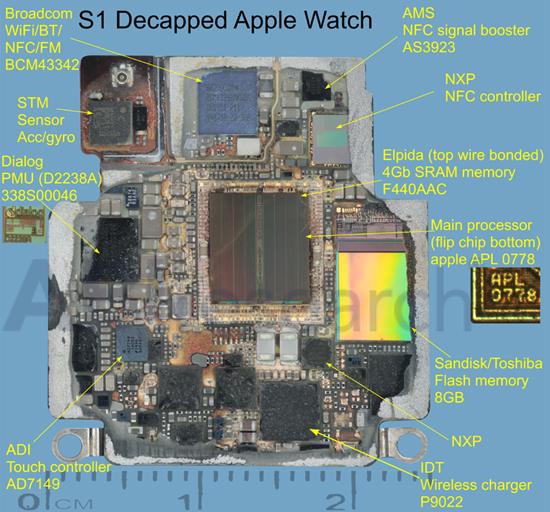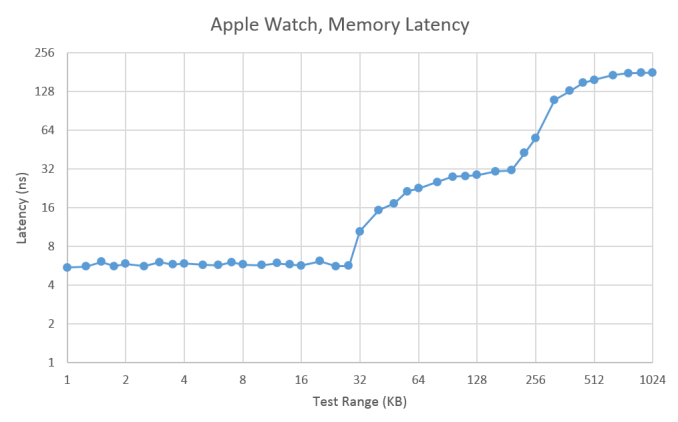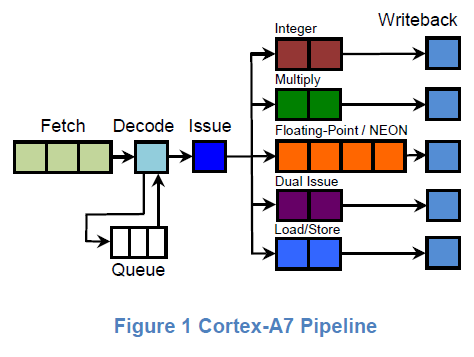The Apple Watch Review
by Joshua Ho & Brandon Chester on July 20, 2015 8:00 AM EST- Posted in
- Wearables
- Apple
- Mobile
- Apple Watch
Apple S1 Analysis
One of the biggest issues with the smartwatch trend that I’ve seen is that as a result of most companies entering the market with smartphone backgrounds, we tend to see a lot of OEMs trying to shove smartphone parts into a smartwatch form factor. There have been a lot of different Android Wear watches, but for the most part everything seems to use Qualcomm’s Snapdragon 400 without the modem. Even though A7 is relatively low power for a smartphone, it’s probably closer to the edge of what is acceptable in terms of TDP for a smartwatch. Given that pretty much every Android Wear watch has around a 400 mAh battery at a 3.8 or 3.85 volt chemistry to attempt to reach 1-2 days of battery life and a relatively large PCB, the end result is that these smartwatches are really just too big for a significant segment of the market. In order to make a smartwatch that can scale down to sizes small enough to cover most of the market, it’s necessary to make an SoC specifically targeted at the smartwatch form factor.

Capped Apple S1 SoC (Image Courtesy iFixit)
The real question here is what Apple has done. As alluded to in the introduction, it turns out the answer is quite a bit. However, this SoC is basically a complete mystery. There’s really not much in the way of proper benchmarking tools or anything that can be run on the Watch to dig deeper here. Based on teardowns, this SoC is fabricated on Samsung’s 28nm LP process, although it’s not clear which flavor of LP is used. It’s pretty easy to eliminate the high power processes, so it’s really just a toss-up between HKMG and poly SiON gate structure. For those that are unfamiliar with what these terms mean, the main difference that results from this choice is a difference in power efficiency, as an HKMG process has less leakage power. Given how little cost is involved in this difference in process compared to a move to 20/14nm processes, it’s probably a safe bet that Apple is using an HKMG process here especially when we look at how the move from 28LP to 28HPm at TSMC dramatically affected battery life in the case of SoCs like Snapdragon 600 and 800.

Decapped & Labeled S1 SoC (Image Courtesy ABI Research)
We also know that binaries compiled for the watch target ARMv7k. Unfortunately, this is effectively an undocumented ISA. We know that Watch OS is built on iOS/Darwin, so this means that a memory management unit (MMU) is necessary in order to make it possible to have memory protection and key abstractions like virtual memory. This rules out MCU ISAs like ARMv7m even if it's possible to add an MMU to such an architecture, so it’s likely that we’re looking at some derivative of ARMv7-A, possibly with some unnecessary instructions stripped out to try and improve power consumption.
The GPU isn’t nearly as much of a mystery here. Given that the PowerVR drivers present in the Apple Watch, it’s fairly conclusive that the S1 uses some kind of PowerVR Series 5 GPU. However which Series 5 GPU is up to debate. There are reasons to believe it may be a PowerVR SGX543MP1, however I suspect that it is in fact PowerVR's GX5300, a specialized wearables GPU from the same family as the SGX543 and would use a very similar driver. Most likely, dedicated competitive intelligence firms (e.g. Chipworks) know the answer, though it's admittedly also the kind of information we expect they would hold on to in order to sell it to clients as part of their day-to-day business activities.
In any case, given that native applications won’t arrive until WatchOS 2 is released I don’t think we’ll be able to really do much in the way of extensive digging on what’s going on here as I suspect that graphics benchmarks will be rare even with the launch of WatchOS 2.
Meanwhile, after a lot of work and even more research, we're finally able to start shining a light on the CPU architecture in this first iteration of Apple's latest device. One of the first things we can start to look at is the memory hierarchy, which is information crucial to applications that require optimization to ensure that code has enough spatial and/or temporal locality to ensure that code is performant.
As one can see, there’s a pretty dramatic fall-off that happens between 28 and 64KB of “DRAM”, as we exit the local maximum of L1 data cache, so we can safely bet that the L1 data cache size is 32KB given current shipping products tend to fall somewhere between 32 and 64KB of L1 data cache. Given the dramatic fall-off that begins to happen around 224KB, we can also safely bet that we’re looking at a 256KB L2 combined cache which is fairly small compared to the 1-2MB shared cache that we might be used to from today’s large smartphone CPUs, but compared to something like an A5 or A7 it’s about right.
If Apple had just implemented the Cortex A7 as their CPU of choice, the obvious question at this point is whether they’ve really made anything “original” here. To try and dive deeper here, we can start looking past the memory hierarchy and looking closer at the machine itself. One of the first things that is obvious is that we’re looking at a CPU with a maximum frequency of 520 MHz, which is telling of the kind of maximum power that Apple is targeting here.
| Apple S1 CPU Latency and Throughput | ||||
| Instruction | Throughput (Cycles/Result) | Latency (Cycles/Result) | ||
| Loads (ldr reg,[reg]) | 1 | N/A | ||
| Stores (str reg,[reg]) | 1 | N/A | ||
| Move (mov reg, reg) | 1/2 | - | ||
| Integer Add (add reg, reg, imm8) | 1/2 | - | ||
| Integer Add (add reg,reg,reg) | 1 | 1 | ||
| Integer Multiply (mul reg,reg,reg) | 1 | 3 | ||
| Bitwise Shift (lsl reg,reg) | 1 | 2 | ||
| Float Add (vadd.f32 reg,reg,reg) | 1 | 4 | ||
| Double Add (vadd.f64 reg,reg,reg) | 1 | 4 | ||
| Float Multiply (vmul.f32 reg,reg,reg) | 1 | 4 | ||
| Double Multiply (vmul.f64 reg,reg,reg) | 4 | 7 | ||
| Double Divide (vdiv.f64 reg,reg,reg) | 29 | 32 | ||
Obviously, talking about the cache hierarchy isn’t enough, so let’s get into the actual architecture. On the integer side of things, integer add latency is a single cycle, but integer multiplication latency is three cycles. However, due to pipelining integer multiplication throughput can produce a result every clock cycle. Similarly, bitshifts take two cycles to complete, but the throughput can be once per clock. Attempting to interleave multiplies and adds results in only achieving half the throughput. We can guess that this is because the integer add block and the integer multiply block are the same block, but that doesn’t really make sense because of just how different addition and multiplication are at the logic level.
Integers are just half of the equation when it comes to data types. We may have Booleans, characters, strings, and varying bit sizes of integers, but when we need to represent decimal values we have to use floating point to enable a whole host of applications. In the case of low power CPUs like this one, floating point will also often be far slower than integers because the rules involved in doing floating point math is complex. At any rate, a float (32-bit) can be added with a throughput of one result per cycle, and a latency of four cycles. The same is true of adding a double or multiplying a float. However, multiplying or dividing doubles is definitely not a good idea here because peak throughput of multiplying doubles is one result per four clock cycles, with a latency of 7 clock cycles. Dividing doubles has a peak throughput of a result every 29 clock cycles, with a latency of 32 clock cycles.
If you happen to have a webpage open with the latency and throughput timings for Cortex A7, you’d probably guess that this is a Cortex A7, and you’d probably be right as well. Attempting to do a load and a store together has a timing that indicates these are XOR operations which cannot be executed in a parallel manner. The same is true of multiplication and addition even though the two operations shouldn’t have any shared logic. Conveniently, the Cortex A7 has a two-wide pipeline that has similar limitations. Cortex A5 is purely single-issue, so despite some similarity it can't explain why addition with an immediate/constant value and a register can happen twice per clock.
Given the overwhelming amount of evidence at the timing level of all these instructions, it’s almost guaranteed that we’re looking at a single core Cortex A7 or a derivative of it at 520 MHz. Even if this is just a Cortex A7, targeting a far lower maximum clock speed means that logic design can prioritize power efficiency over performance. Standard cells can favor techniques and styles that would otherwise unacceptably compromise performance in a 2+ GHz chip could be easily used in a 520 MHz chip such as device stacking, sleepy stack layout, higher Vt selection with negative active body biasing, and other techniques that would allow for either lower voltage at the same frequency, or reduced capacitance in dynamic power and reduced static leakage. Given that Cortex A7 has generally been a winning design for perf/W metrics, I suspect that key points of differentiation will come from implementation rather than architecture for the near future. Although I was hoping to see Apple Watch on a more leading-edge process like 14LPP/16FF+, I suspect this will be deferred until Apple Watch 2 or 3.












270 Comments
View All Comments
fred deer - Monday, July 20, 2015 - link
Anandtech has put their Apple buttkissing into overdrive now that Anand works for them.Where is the objectivity Anandtech was once famous for? Why does Anandtech feel the need to make excuses for Apples shortcomings? They only do this for Apple products. Here are two examples, the watch is slow, but we know Apple will improve this. The apps aren't very good but they'll get better over time. You suck Appletech.Smog35 - Monday, July 20, 2015 - link
The price is steep to finger this.KPOM - Monday, July 20, 2015 - link
So I see the anti-Apple crowd is out in force here. It's interesting to see a tech reviewer with a mostly positive view. A Wristly survey seems to show that non-techie people like the Watch better than techie people. Perhaps it's because they see the Watch for what it is, and aren't judging it solely as a tech product.At the same time, it's good to get an AnandTech view, since they are very good at addressing the limitations of the technology and giving us a sense of what we can reasonably expect for the future. Move this to a 14nm process, or even a 10nm process in a few years, and the Watch may be a lot more fluid and last even longer.
Impulses - Monday, July 20, 2015 - link
I appreciate having an AT review of the Watch, regardless of tone, if nothing else because they'll be more meticulous than almost any other site so it'll actually be worth reading even if I don't necessarily agree with the conclusion.My only quibble is that there seems to be multiple allusions to other wearables but they're never directly compared or even mentioned. I realize that the iOS buyer that's thinking of getting an Apple Watch is probably not cross shopping much but still...
Any other wearable review will surely feature plenty of direct comparison to the Watch. There's things that work very differently across the field, but even when it comes to highly subjective things like fit there ARE points of comparison.
For instance, something like the distance from strap lug to lug can vary greatly independently of actual watch size and it's something casual blog reviews don't really pay attention to.
dusk007 - Monday, July 20, 2015 - link
I think the anit-AppleWatch vibe is strong with how many posts are phrased here but still there is some truth in it. The reviewer only mentioned the rather old Moto 360 as a state of the art comparison. Nothing about the 42mm diameter Huawei watch that looks really good and much better than the moto 360 which was first to market but is old tech today. G watch R and what they are all called.I love AT reviews about chip architectures and stuff, but where Apple is concerned they always had quite bit lacking in objectivity I feel. Maybe a Huawei Watch review will balance the scales.
Personally I still don't see this device really taking root outside of the die hard Fanboys and tech geek crowd. I have read a few reviews but a wrist watch is still a bother (I never found one uncomfortable just annoying), the Apple one is especially expensive and they seem to solve little that needs solving. It is nonessential, a bit of a techy toy and expensive, I don't see it taking off. iPhones are subsidiced, ipads are family devices, that justifies the cost. For the watch I don't see the big market that whole smartwatch industry is hoping for.
SR22pilot - Monday, July 20, 2015 - link
Data says non-techies are happier than techies. My experience backs it up. My girlfriend loves hers. It has taken longer for it to grow on me. It isn't an iPad that entertains. Apple Watch reduces your time consumed with technology. As for the review, my disagreement is with the statement that heart rate doesn't belong on a glance. My girlfriend had a heart issue and loves having heart rate easily accessible.JoshDouble - Tuesday, July 21, 2015 - link
The Huawei Watch hasn't been released yet. "According to He Gang, an executive from Huawei’s smartphone division, it’s the Android Wear platform that’s causing problems. The company is adapting Android Wear to work without Google’s services in China, where they aren’t available, and to adopt Huawei’s suite of apps instead. It’s a time-consuming and highly technical operation, and has forced Huawei to push the release date until September at the earliest."Haters are gonna hate it, but Apple has nailed it once again and is already dominating this new market.
dusk007 - Tuesday, July 21, 2015 - link
To not have the fragmentation problems, Google from the start did not allow any skinning of Android Wear. I see how that might be an issue for Huawei. But from a pure hardware perspective it is the prettiest device I have seen.Daniel Egger - Monday, July 20, 2015 - link
> So I see the anti-Apple crowd is out in force here. It's interesting to see a tech reviewer with a mostly positive view. A Wristly survey seems to show that non-techie people like the Watch better than techie people. Perhaps it's because they see the Watch for what it is, and aren't judging it solely as a tech product.That's exactly what I don't understand: The Apple Watch is a horrible watch (actually not much different from pretty much any other smartwatch on the market...). Two items are essential for *any* item which wants to be coined a watch: Decent battery life and permanent readability. The Pebble gets very close to that; anything else is simply a complete failure.
Call the Apple Watch a status symbol, a geek tool, a toy, jewelry ... but please not a watch.
tipoo - Monday, July 20, 2015 - link
"I’ve never really used a fitness tracker that keeps track of something as simple as standing time, which seems like an obvious metric to track as soon as you start using the fitness functions of the watch because sitting for extended periods of time can have significant effects on health regardless of how much exercise you do. "I don't really get this aspect of the Apple Watch's fitness part. It makes you stand for a total of minutes more per day, you could fill that entire bar while still sitting most of the time, like I suspect most people would still be doing in office jobs and such. Would that really make a difference? Everyone knows sitting too much is bad, but how can standing for a minute per hour or whatever make any difference?